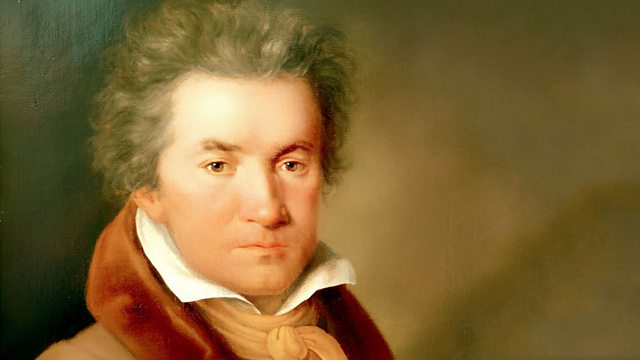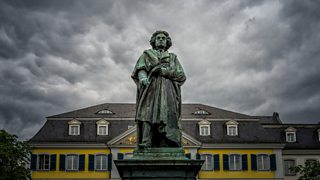
Beethoven and the Early Signs of Deafness
Donald Macleod surveys Beethoven's career in 1801, including the early signs of deafness.
Donald Macleod explores the life and music of Beethoven, taking a snapshot view through the window of five of the composer's thirty-two piano sonatas.
Beethoven was now quite successful by 1801, supported by a most generous patron Prince Lichnowsky, who had previously been an important patron of Mozart's. Commissions meant that Beethoven was now being taken seriously as a composer, and one such commission was for the stage. This provided Beethoven with the opportunity of writing ballet music for The Creatures of Prometheus, which proved so popular it was performed many times that year.
Beethoven was not above criticism though, and was aware that he still needed to develop his compositional skills and technique. This included having lessons from the major Viennese composer Antonio Salieri, who set the younger composer exercises in writing for voice. A number of these unaccompanied partsongs survive, including Nei campi e nelle selve, WoO 99.
At this time however, there were increasing signs that Beethoven was suffering from hearing difficulties. His friends noticed that Beethoven would often have cotton wool soaked in almond oil protruding from his ears. This, combined with other periods of illness, could have been one reason for Beethoven turning to religious songs, including composing The Glory of God in Nature opus 48.
1801 was also a time for composing further piano sonatas, numbers twelve to fifteen. One of Beethoven's favourite piano sonatas would be written during this period: the Piano Sonata No.15 in D major, otherwise known as the "Pastoral".
Last on
Music Played
-
![]()
Ludwig van Beethoven
Die Geschopfe des Prometheus - ballet music Op.43
Conductor: Charles MACKERRAS Performer: Scottish Chamber Orchestra
- HELIOS.
- CDH-55196.
-
![]()
Ludwig van Beethoven
Nei campi e nelle selve WoO.99.7b for 4 voices [SATB] [36 bars;incipit-2/4:e:eeee:e dc:]
Conductor: Diego FASOLIS Performer: Italian Swiss Radio Chorus
- Arts.
- 475192.
-
![]()
Ludwig van Beethoven
Fra tutte le pene WoO.99.3b for soprano, alto and tenor
Conductor: Diego FASOLIS Performer: Italian Swiss Radio Chorus
- Arts.
- 475192.
-
![]()
Ludwig van Beethoven
Chi mai di questo core WoO 99/2
Conductor: Diego FASOLIS Performer: Italian Swiss Radio Chorus
- Arts.
- 475192.
-
![]()
Ludwig van Beethoven
Quella cetra ah pur tu sei WoO.99.10c for soprano, alto, tenor and bass
Conductor: Diego FASOLIS Performer: Italian Swiss Radio Chorus
- Arts.
- 475192.
-
![]()
Ludwig van Beethoven
Giura il nocchier WoO.99.5a for soprano, alto, tenor and bass
Conductor: Diego FASOLIS Performer: Italian Swiss Radio Chorus
- Arts.
- 475192.
-
![]()
Ludwig van Beethoven
Gia la notte s'avvicina WoO.99.4a for soprano, alto, tenor and bass
Conductor: Diego FASOLIS Performer: Italian Swiss Radio Chorus
- Arts.
- 475192.
-
![]()
Ludwig van Beethoven
Sonata no. 15 in D major Op.28 (Pastoral) for piano
Performer: Angela HEWITT - Piano
- HYPERION.
- CDA-67605.
-
![]()
Ludwig van Beethoven
6 Songs Op.48 [C F Gellert]
Performer: Peter SCHREIER - Tenor Performer: Walter OLBERTZ - Piano
- Teldec.
- 844061.
-
![]()
Ludwig van Beethoven
Quintet in C major Op.29 for strings
Performer: Nash Ensemble
- Hyperion:.
- CDA67693.
Broadcasts
- Tue 24 Jul 2012 12:00����ý Radio 3
- Tue 24 Jul 2012 18:00����ý Radio 3
Beethoven Unleashed – the box set
What was really wrong with Beethoven?
Composers A to Z
Who knew? Five eye-opening stories from Composer of the Week
Five reasons why we love Parry's Jerusalem
What is the strange power of Jerusalem which makes strong men weep?
A man out of time – why Parry's music and ideas were at odds with his image...
The composer of Jerusalem was very far from the conservative figure his image suggests.
Composer Help Page
Find resources and contacts for composers from within the classical music industry.





